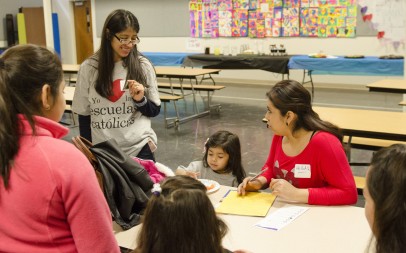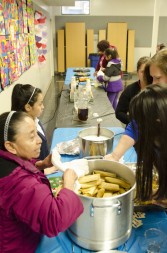March 28, 2017 // Schools
Dual-language immersion track proposal well received
SOUTH BEND — Holy Cross School, South Bend, held an open house on March 15 to inform the community about a new dual-language immersion track being developed for pre-kindergarten and kindergarten classes beginning next fall. Families were invited to tour classrooms, receive information about financial aid, hear presentations, enjoy fellowship while eating tamales and speak with experts regarding the details of the new track. Many families, both Spanish-speaking and English-speaking, were in attendance and the new track was received with excitement.
The dual-language immersion opportunity, which will complement the existing English-language track, is a result of collaboration with the University of Notre Dame’s Institute for Latino Studies and the Alliance for Catholic Education. Dr. Luis Fraga of the Institute for Latino Studies and Dr. Katy Lichon of ACE were present at the open house to share their knowledge of immersion programs and to answer questions for families. The University of Notre Dame is helping Holy Cross School structure its program, and will be available as a resource in the developmental years.

Dulce Curry (left) speaks with Abigail, the mom of Ximena, the very first student to enroll in the new immersion program at Holy Cross School.
Fraga and Lichon presented information about the program in both English and Spanish, discussing the benefits of dual immersion in schools. With a Spanish-to-English ratio of 90/10 in the pre-kindergarten and kindergarten classes, which moves gradually to a 50/50 split by the fifth grade, students in the program will be literate and fluent in both languages by around the fourth or fifth grade. In the beginning, the English portions of the track will come from specials classes such as gym, art and music, in which students from both tracks will participate together.
Holy Cross School will utilize Add.a.lingua, a company based out of Zeeland, Mich., to help implement the dual-language track.

Maria Guadalupe Abrajan, Holy Cross School grandmother, shares tamales with crowds gathered to learn about the new Spanish-English immersion program.
Three teachers, Jo Jones, Febe Gomez and Angela Gonzalez Urbina from Corpus Christi School in Holland, Mich., were present to answer questions regarding the successes of dual-language immersion in their school. Corpus Christi School is in the third year of offering Spanish immersion. It has also had success by offering a more authentic Spanish class with a native Spanish-speaking teacher for those in the traditional track. Jones said that learning from native speakers at a young age gives children a gift of language in a natural way.
“Our students change from Spanish to English like they change socks. If a student were to go into the hallway and ask me a question in Spanish through the door, I would not know what that child looked like based on their accent.”
Children’s brains between the ages of 3 and 6 are so open to learning that they will be able to fully grasp the basis of both languages when given the opportunity.
“Our school has also benefitted from the cultural shift of incorporating the dual-immersion track.” Jones said. Her school has also seen an increase in Latino parent volunteers since the switch. Previously, many Spanish-speaking parents were hesitant to volunteer, but the new track requires aides to be native Spanish-speakers. The inclusion has led to overall better collaboration and a stronger sense of community.
Although the educational impact of the dual-language immersion program is significant, Dr. Michael Griffin, a member of the Holy Cross School Board, says the motivation for the program lies on a deeper level.
“Holy Cross School has the opportunity to incarnate the Gospel and the vision of Pope Francis and Bishop Kevin Rhoades for the church of the future. … Catholic schools have a reputation of being ‘private’ schools, but they are not. We are a community school. We are different cultures, but one faith.”
Griffin feels that Holy Cross, as a school with a large mix of cultures, has always been a place that promotes social justice and inclusion. Now it has an opportunity to expand that even more and to be innovative in the realm of Catholic education.
According to Fraga, only 3 percent of Latino youth attend Catholic schools, although Latinos make up 35 to 40 percent of all Catholics in the United States. Minorities tend to feel excluded from Catholic schools, but it should not be that way, he said. The dual-language immersion program is an opportunity to “build communities of access and inclusion across all Catholic faithful.”
Principal Angela Budzinski, as well as current teachers at Holy Cross School, have been supportive of the addition of the dual-language track as a way to utilize extra classrooms at the school while providing the best holistic education.
Holy Cross will be the first area Catholic school to offer such a program, but hopes are that more Catholic schools will follow suit.
Some spaces are still open for both the dual-language and traditional tracks, but parents are encouraged to contact the school soon if interested in visiting or registering. Call Holy Cross School at 574-234-3422 for information.
The best news. Delivered to your inbox.
Subscribe to our mailing list today.






